Verein Roseninsel Park Wilhelmshöhe e. V.
The History of the Wilhelmshöhe Rose Collection
- The History of the “Wilhelmshöhe” Rose Collection
- Landgrave Friedrich II and his court gardener, Daniel August
Schwarzkopf, recreate the Weissenstein
Park as a landscape garden and start a rosarium. - The Pearl of Weissenstein” – Germany’s oldest cultivated rose
- The 134 Watercolour Paintings by Salomon Pinhas
- Wilhelmshöhe’s Roses Sent to Malmaison
- 10,000 Roses for Wilhelmshöhe Park
- The End of Wilhelmshöhe’s Collection of Roses
- The new Collection of Shrub Roses at Wilhelmshöhe’s Park
- Appendix:
Sources for the history of the rosarium - Sources of the Pictures
Rose enthusiasts from Kassel in the German Rose Association made an agreement with the administrators of the State Palaces and Gardens in Hesse to regenerate the bush rose collection which has a long previous history.
About 1143 a monastery was founded at the edge of the Habicht Forest overlooking the town of Kassel. The monks and later the nuns of this monastery cultivated as was usual at the time medicinal plants in their gardens. Included in these plants were the indigenous wild roses; the Dog Rose (rosa canina), the Apple Rose (rosa villosa), the Sweetbriar Rose (rosa rubiginosa) and the Lancashire Red Rose, Apothecary’s Rose (rosa gallica). Possibly later this collection was enlarged with full bloom roses (rosa x alba and rosa x damascena).
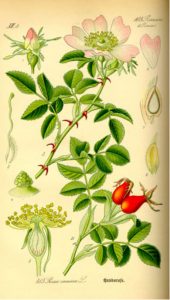
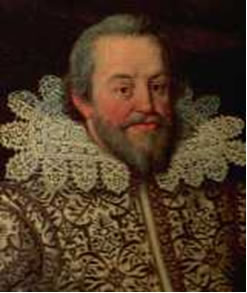

In 1606 Landgrave Moritz of Hessen-Kassel built a hunting lodge on the site of the monastery disbanded in 1526 and crated a park around it. The father of Landgrave Moritz, Wilhem IV (1567-1592) was not only an authority on astronomy and mathematics but also an avid botanist. He kept up an extensive correspondence which is partly preserved and from which we know about his collection of plants in 1588 in his pleasure garden in the “Fuldaaue”.
This park, now called the “Karlsaue”, can be considered as one of the earliest botanical gardens in Germany. Just concerning his roses, he sent his brother-in-law, Hedwig of Heesen-Marburg “quite a few hundred bushes of double roses and white roses.“ He acquired thirteen different species of roses from Count Neuenaar in 1590. With other collectors he exchanged Musk Roses.
Carolus Clusius, the most famous botanist at this time, with whom Wilhelm IV corresponded, relates that the Imperial Marshal in Hesse, Georg von Riedesel, was like his Landgrave an enthusiast of the “studii Herbari” – and in his garden (Ludwigseck, in the county of Hersfeld-Rothenburg) there was one of the largest collections of roses at that time. It is quite likely that on account of Landgrave Moritz, who inherited his father’s the botanical interests, that the well-known roses at that time were planted in the Renaissance garden in Park Weissenstein.
Almost a hundred years later Landgrave Carl (1670-1730), the great grandson of Moritz, created the grandiose Baroque park with a large palace, a large statue of Hercules on a tower on a height of the Habichtswald Forest, the cascades, the trick fountains and a magnificent avenue. There were no roses in the Baroque park. There were rediscovered as garden plants in the first half of the eighteen century.
A rose walk is first mentioned at the Weissenstein hunting lodge in the middle of the eighteenth century,he so-called “Berceau” which in all probability was planted with the “Tapentenrose” (rosa turbinata = rosa x francofurtana, a hybrid of the rosa gallica).
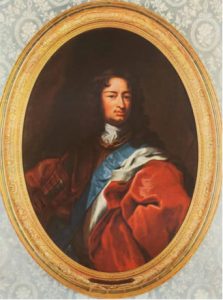
Landgrave Friedrich II and his court gardener, Daniel August Schwarzkopf, recreate the Weissenstein Park as a landscape garden and start a rosarium.
Landgrave Friedrich II (1760-1785) was the regent during the Age of Enlightenment and Mercantilism. Returning after the Seven Years War (1756-1763) to his seat of power in Kassel after the withdrawal of the French, he attempted through reforms and the promotion of industry in his country to compensate for the damage caused by the war. Great efforts were made to develop agriculture and fruit growing and gardening. (1).
But at the same time the exhibiting of his status and power was considered to be essential for an absolute prince in his foreign and domestic affairs, this included the patronage for architecture and landscape design. Friederich II planned in accordance with the prevailing taste of his time to redesign his hunting lodge, Weissenstein, into a summer residence. (24)
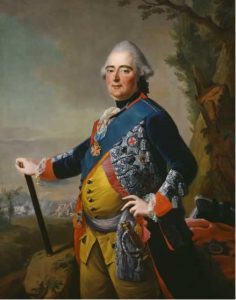
he austere architecture of the Baroque was replaced by a completely different concept of landscape gardening. The idea of “Back to Nature” found its expression first of all in English landscape gardening. There parks were designed, inspired by Chinese ones, that created a romantic landscape. This new development in landscape gardening was called the “English” landscape park. Weissenstein Park offered because of its diverse hillside location and plentiful supplies of water manifold possibilities for the construction of a landscape park with collections of trees and bushes from around the world.Friederich II sought a gardener for the designing of this park who was well acquainted with the new “English” landscape parks. The most famous German tree nursery expert at this time was Baron von Veltheim from Harbke near Helmstedt. He recommended to the Landgrave the gardener, Daniel August Schwarzkopf, who had been trained by him and Philip Miller, the well known English master gardener in Chelsea, London. Schwarzkopf pointed out when given the job the importance of having a financially viable nursery to maintain a landscape park. This suggestion appealed to the Landgrave’s mercantile ideas. It turned out in the future that Schwarzkopf’s suggestion was quite justified and the tree nursery became one of the biggest in Germany. Without it the great variety in the planting of Weissenstein Park is unimaginable. (State Archives Marburg: Schwarzkopf)

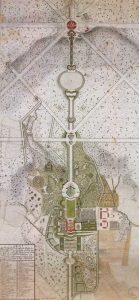

Immediately after the appointment of Schwarzkopf in 1766 a large selection of plants was ordered from Harbke, Schwöbber, Münchhausen’s tree nursery and from England including roses. Both the prince and his court gardener were particularly fond of roses. Compared to the seventeenth century the number of roses and their varieties had increase considerably.
Dr. Christoph Heinrich Böttger, physician, botanist and the prorector of the Carolineum the Kassel University at that time published a register of the foreign and native trees and shurbs which could be found in the princely gardens of the summer residence, Weissenstein. In it he describes together with trees and shrubs 25 varieties of roses (cf. Appendix) and explains in his concluding remarks after describing the roses that : “I would fall far short of my intention if I wanted to list even more roses. Nevertheless it cannot be overseen that his excellency here among other things has had particular rose gardens and nurseries planted where the court gardener’s diligence together with the many varieties including their subspecies is over a hundred……” (6)
A compliation of woody plants from the nurseries in Schwöbber, Harbke and Weissenstein is given in Becker’s pocket book for gardening enthusiasts published in 1783. (5) Unfortunately the Wissenstein roses are not listed separately. It is simply stated: “Apart from trees and shrubs Mr. Schwarzkopf owns one of the most numerous and exquisite collections of roses.”
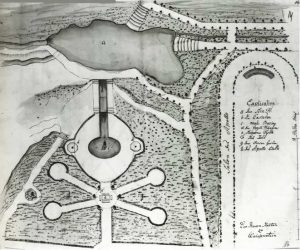
Dr. C. H. Böttger’s successor at the Carolineum, Conrad Mönch, published a new compilation of the foreign trees and shrubs in 1785. Mönch writes in his preface: “….. the present court gardener, Mr. Schwarzkopf is the first person to cultivate these foreign plants…. This new garden fashion has been the cause of a great deal of practical benefit. Europe has not received and been the beneficiary of so many new and generally useful plants since Roman times, on account of this changing fashion in gardens.” Among Mönch’s descriptions of the park’s roses – he mentions 150 different types and 49 species – he writes, “For the last twelve years Mr. Schwarzkopf has sown many of the varieties to be found here every year and has obtained quite a few noticeable variations.” (21)
In “The Letters of a Traveller about the present Condition of Cassel” Baron von Günderode wrote in 1781 in his letter concerning Weissenstein Park, “There are great numbers of roses and of such variety that one would not find elsewhere and what is also unusual, namely roses without thorns. From the present court gardener, Mr. Schwarzkopf, who is really most skilful and particularly in the cultivation of trees a recognised expert, it is possible to obtain many species of trees and roses for a very low price as you can see from the published catalogue.“ (9) Already in 1781 there was a printed catalogue of roses no copy of which has been found up until now. One must not imagine that the collection of roses in Weissenstein Park was planted as a separate rosarium. They stood in small groups with other bushes and trees about the park and in the tree nurseries for further propagation or for sale.
There was, however, in 1767 a planted rose garden of which a sketch exists, now in the hands of the Wilhelmshöhe garden administration, and which Holtmeyer reproduces in his book about Strieder’s account of the transformation of the park into a landscape garden. (14) It concerns a large grove of densely planted roses of the time mainly high bush roses. In the middle of the roses there was an oval space with two aviaries on either side of a pool into which water cascaded fed by a pond. From an joining space protected by a canopy four paths led into the grove so that one could enjoy and appreciate the roses with all one’s senses This Rococo layout did not fit in with the concept of an English landscape garden. Paetow (24) wrote that “The whole layout contains a contradiction which one must put down to the insouciance of the times concerning questions of style. The old layout has not completely lost its charm but the new landscaping ideas are already being used. This small grove (of roses) is typical, a serious stylistic intention is missing!” Probably for this reason the Landgrave Wilhelm IX had the grove removed in 1786.
Relics of this grove of roses can be seen in an engraving by Weise copied from a painting by J. H. Tischbein, the elder (1788); five to six feet high rose bushes can be seen beneath the Weissenstein wing of today’s palace. A further picture of Tischbein’s shows roses among the park’s groups of trees.


When Landgrave Wilhelm IX – from 1803 Prince Elector Wilhelm I – started to govern in 1785 Weissenstein Park was completely refashioned as unadulterated landscape park and in the place of the Weissenstein Palace the Wilhelmhöhe one, named after the landgrave, was built from 1789 onwards.
The collection of roses was not only maintained due to the tree nursery but was enlarged. Roses were planted in long rows on the “Island of Roses” created at the end “Lacs” in 1789 from the heaped up debris of the demolished Weissenstein Palace. This island is shown in a gouache by the Swiss landscape painter, Joh. Heinrich Bleuler at the beginning of the nineteenth century.
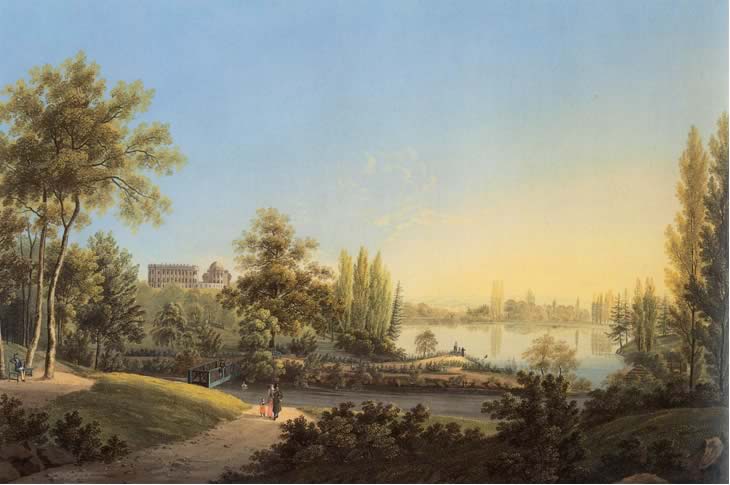
“The Pearl of Weissenstein” - Germany's oldest cultivated rose
he botanist Dr. Gerd Krüssmann concludes in his book “Roses, Roses, Roses” published in 1974 using several sources that “The first person in Germany to name and cultivate a rose was the Court Gardener of Landgrave Friedrich II of Hesse, Schwarzkopf, at Weissenstein Palace near Cassel. His rose was named “Pearl of Weissenstein”. Schwarzkopf had been court gardener there since 1766 and also created its rosarium which presumably was the first one in Germany.“ (17)
Unfortunately up until now we have been unable to establish the exact date of the oldest German rose’s creation. We assume from Mönch’s references sometime between 1773 and 1785. The rose appears first in 1808 in various German and French indices, for example, sales catalogues. French indices used a bowdlerized version of the name “Perle de Vaseingtein”. Under this name Jäger put it into his “Lexicon of Roses”. In the famous works of Redoute and Thory it is referred to as “R. provins perle de Veisseuslein”.
Schwarzkopf produced quite a number of further roses at Weissenstein / Wilhelmshöhe which have unfortunately all vanished. Rössig had two of these roses drawn in 1826 for his beautifully illustrated work on roses. They were the R. holoserica regalis and the large poppy headed rose. (27) He wrote of the former, “This variety, as far as I know, was cultivated from seed by the Garden Director Schwarzkopf at Napoleonshöhe. “( This is what Wilhelmshöhe was called during Jerome’s regency from 1807 till 1814). Concerning the second rose he maintains that Schwarzkopf cultivated it from the seeds of the Rosa gallica. In accordance with Pinhas’s drawings and the tree nursery catalogues from 1811, 1819 and 1851 Schwarzkopf probably also cultivated the roses “Belle de Weissenstein, Pourpree de Weissenstein, Rose Petite Hessoise and Rose Centifolie de Hesse”. Mönch cites eight examples of roses cultivated at Weissenstein. In “Modern Roses 8 (1980) there is a rose called “Hessoise” (Rubiginosa, semi-double, light red). A search in the United States was partly successful and we were sent a single flowering “Hessoise”. According to Simon and Cochel there were ten different R. rubiginosa of this name.
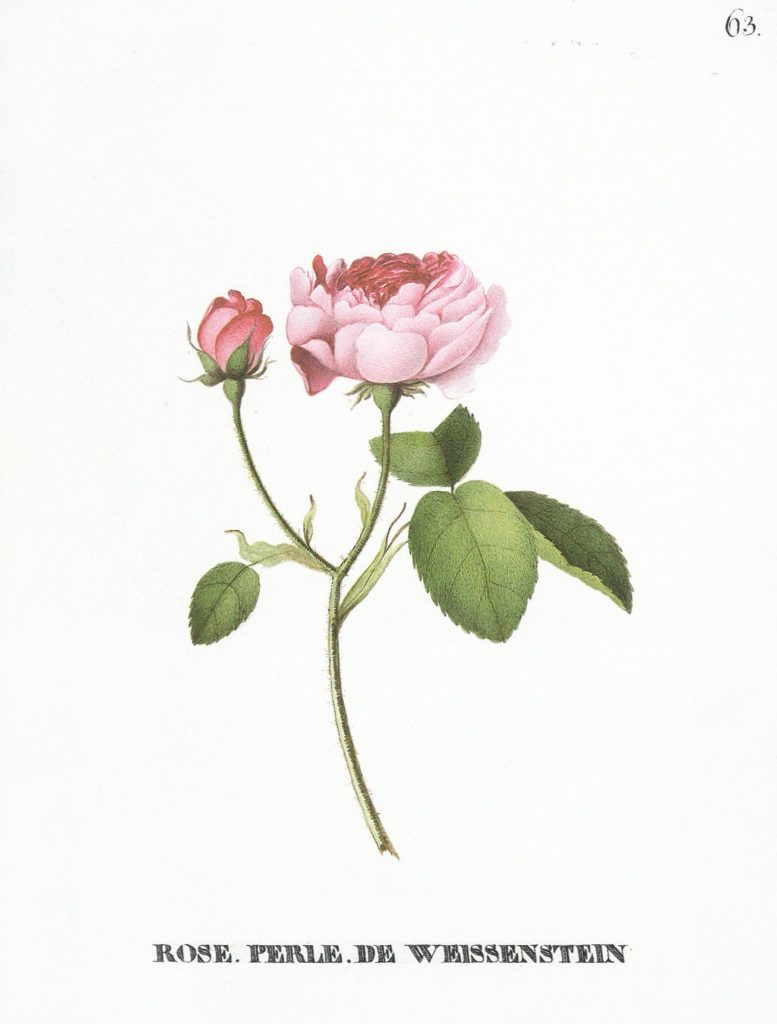
The 134 Watercolour Paintings by Salomon Pinhas

While searching for old plans of the Weissenstein rose garden in the palace library, we came across a bound collection of 133 watercolour paintings with a cover picture. These paintings were practically unknown in spite of their clarity of colour, their graceful beauty and their botanical value. This sensational discovery deeply moved us as there are very few painters of roses with such a substantial oeuvre. The collection of roses in Wilhelmshöhe had thus, just like Malmaison in Redoute, found its painter. Once photographed the watercolours could help us to identify the roses in the indices of that time which were listed under quite different names. We gave ourselves subsequently the task, within the bounds of our financial possibilities, to find the still existing roses of Friederich II’s collection and to present them at Wilhelmshöhe with the history of bush roses up until the present day, we also had the additional task of making Salomon Pinhas pictures public and therefore of use.
Salomon Pinhas, born in February 1759 in Bayreuth, came from a Jewish family of painters. His father and grandfather had been painters. He held the position of Court Minature Painter by the Landgrave and later Prince Elector Wilhem I in Cassel from 1788 onwards. His function was to be the court “photographer”; he painted miniaturess of the court’s members and of Cassel’s citizens and copied pictures in Cassel’s Gallery. He is known for a series of pictures depicting the uniforms of the Westphalian army which unfortunately were burnt in the last war. His miniatures have been scattered in such a way that up until now only reproductions in the magazine “Cicerone” from 1916 have been discovered but no further pictures.
The idea to have the collection of roses at Wilhelmshöhe painted came from the Prince himself. In the State Archives in Marburg there is a written request to the Prince Elector from Pinhas “while working on his book of roses” in 1806 for the granting of more remuneration to enable him to have a secure future existence in Cassel. In the same year the Prince Elector had to leave Cassel. The brother of Napoleon, Jerome, the King of Westphalia from 1807 until 1813, moved into the Wilhelmshöhe Palace.
After regaining his throne the Prince Elector had a title page painting added to the still remaining 133 watercolours and had them bound in 1815. Since that time they have remained on the bookshelves of the palace. According to the book’s index 17 watercolours are missing. A search in Malmaison was unsuccessful. A comparison with Redoute’s rose paintings and Thory’s text is interesting. Redoute is of the same age as Pinhas. Redoute’s rose paintings were printed with their description by the botanist Thory, whereas Pinhas’s paintings have no commentary. Neither painter knew anything about the other one. Redoute’s work has become world famous, Pinhas’s watercolours remained unpublished for a long time. (His work was first published in by the publishers‘ Schnell and Steiner, Regensburg in 2001.)

Wilhelmshöhe's Roses Sent to Malmaison

he manuscript department of Cassel’s Library acquired a letter of Catherina, Queen of Westphalia sent to her sister-in-law Josephine, the Empress of France dated 5th November 1809 which refers to the sending of roses from Wilhelmshöhe to Malmaison, the palace of the Queen near Paris. Translated it reads,
“The King, my dear sister, could not take the roses with him because according to his gardener in the haste of his departure the plants would have been damaged. I will have them sent today to the address of Mr. de la Valette who will deliver them to you. The King departed yesterday evening. You know me well enough, my dear sister, to feel how very much I am saddened and disconsolate today, even more so as this journey which will bring you together with the King and which would have been a cause for twofold pleasure for me. Please, at the very least, think of me, speak about me, about my feelings and my affection for his Majesty; and believe me when I say, my dear sister, that nobody can love you more tenderly than your most devoted sister, Catherina.”
As we can assumed that this was not the only consignment of roses, it seems that there was an exchange of roses between Wilhelmshöhe and the Empress Josephine’s famous collection of roses in Malmaison. This also explains the occurrence of identical names of otherwise unusual roses in Wilhelmshöhe and Malmaison. The collection of roses in Malmaison was lost just like the collection in Wilhelmshöhe. Both collections are now being rebuilt. J. Graveraux had already tried at the beginning of the nineteenth century to ascertain which roses were at Malmaison in the Empress’s time. Those plants he found again he replanted at L’Hay-les-Roses near Paris. Among these roses are some that were also painted by Pinhas at Wilhelmshöhe such as “Beaute Touchante, Belle Parade, Belle sans Flatterie, Couleur de Chair, R.x francofurtensis, Feu amoureux, Illustre, Incomperable, Nouvelle Blanche, Nouvelle Gagnee.”
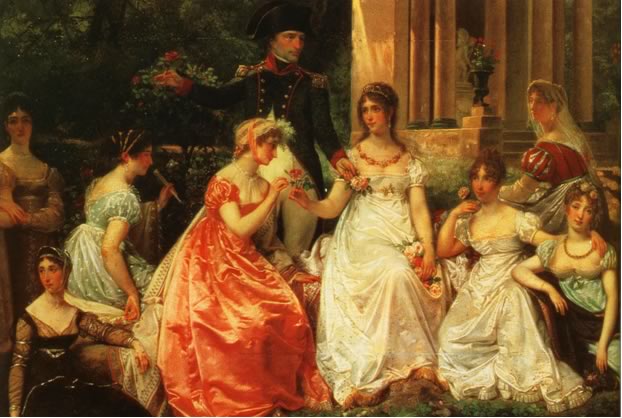
10,000 Roses for Wilhelmshöhe Park
n 1825, that is sixty years after the first laying out of Landgrave Friederich II’s collection of roses, the Prince Elector Wilhelm II decided that the rose collection of his grandfather required a replanting above all with the at that time fashionable full standard roses. He decreed that altogether 10,000 roses had to be cultivated by his court nurseries in Hesse. This decree was not a complete success. In the State Archives in Marburg there is a thick dossier in which all the directives and explanatory notes concerning this “War of the Roses” were collected. Every one of the fourteen court nurseries presented again and again new explanations why they were unable to fulfil the required delivery quota of roses. Finally the Court Gardener Schmidtmann kept quiet about 300 rose trees in the “Karlsaue” in Cassel in order not to completely expose the weaknesses of his area of responsibility. Unfortunately for Schmidtmann he had to suffer for the failure of the whole enterprise. On 9th May 1827 it is recorded: “His Royal Majesty the Prince Elector decrees that the Court Gardener Schmidtmann be imprisoned for an unlimited period of time on bread and water for not declaring the 300 rose trees which he had in his nursery….”

The End of Wilhelmshöhe's Collection of Roses
Again for the year 1851 there exists a printed sales catalogue of the Wilhelmshöhe tree nursery which demonstrates the wide range of roses on offer, 153 different varieties. (4)
In 1866 Cassel became Prussian and as a result Wilhelmshöhe Palace became the summer residence of the Hohenzollern. Around 1870 the tree nursery was closed and with it the basis was destroyed for the continual renewal of the park’s rose collection. Over the years the roses were lost apart from a very small number which one can find scattered about the park.
Doll and Nietner give ample proof of the importance of Wilhelmshöhe’s collection of roses in their well known books on roses from the nineteenth century.
Wilhelm Doll writes in the “Rosengarten”, Leipzig, 1855 (7) “Germany has not been mentioned at all in Paul’s “History of Roses”. Is this justified? In the past the collections at Cassel were famous and even now some old rose lovers will remember the “Pearle von Weissenstein” and many a different variety acquired there.”
The Royal Court Gardener in Potsdam, Th. Nieter, relates in his “Book of Roses” published in 1880, “It was quite clear to us (when replanting the rose garden in front of the orangery at Sanssouci) that it would hardly be possible to obtain 800 rose bushes of a suitable quality in a single nursery at this time in spring. For this reason we placed similar orders in Hamburg, Abtnaundorf, Tetschen and Cassel with gentlemen who we knew personally and from whom we knew that we would only be sent bushes of good quality in spite of this late time of the season.” (23)
A large part of the present tree population at Wilhelmshöhe is due to the master gardener Vetter who was kept on by the Prussian administration in 1866 and the head gardener Wilhem Hentze. Vetter also tried to rejuvenate the park’s collection of roses by establishing a new nursery garden for the development of new types of roses. His memorial stands in front of the large hothouse at Wilhelmshöhe. He was appointed court gardener in Potsdam in 1891. (10)
Also after his time groups of rose bushes are believed to have been planted on the “Island of Roses” which remained reserved as a private garden for the emperor’s court. This is also shown on postcards. However, with the closing of the tree nursery and its sales department the heyday of Wilhelmshöhe’s rose collection was gone.
For the German Federal Garden Show in Cassel in 1955 and also later several groups of roses have been planted.

The new Collection of Shrub Roses at Wilhelmshöhe's Park
(Reprinted with the kind permission of the Eugen Ulmer Publishing House from the book “Old Roses and Wild Roses” by Anny Jacob, Heide and Werner Grimm and Bruno Müller.)
Those who have read of the changing fortunes of Cassel’s rose collections and know the scale of the delightful landscapes of Wilhelmshöhe’s Park will understand that the reawakening of the tradition of a rose collection in Cassel is a matter of great importance for “Cassel’s Club of Rose Enthusiasts” (Kasseler Rosenfreunde). On the occasion of the Rose Congress of the Association Rose Enthusiasts (now the Society of Rose Enthusiasts) initiatives led to the desire to make a contribution to the German Federal Garden Show in 1981. The Rose Enthusiasts in Cassel set themselves the task in 1977 of collecting again the old roses of the eighteenth century which had at one time stood in Wilhelmshöhe Park and were still obtainable. At the same time they wanted to publicise Salomon Pinhas’s work as a painter and using the historical rose gardens and their roses to foster the development and cultivation of shrub roses. Here they wished to give examples with the planting of wild roses, their hybrids and old garden roses as well as more recent park roses. It was not easy to put these ideas into practice. The administration of the state palaces and gardens in Bad Homburg had to be convinced of the importance of this task and of the seriousness of the rose enthusiasts. Wilhelmshöhe Park being an historic edifice should retain and maintain its appropriate style. The design of the “English” garden was subject to strict stylistic rules. In the eighteenth century one had the possibility with the help of troops, the compulsory use of labourers and of horse drawn carts to move nowadays hardly imaginable amounts of earth and to plant groups of trees in order to create the garden areas conforming to the stylistic ideas of the time. In addition trick fountains were built to capture the beauty of nature in a confined space together with a seemingly romantic architecture. The garden spaces with their manifold dendrological botanical populations were meant to captivate the visitor with continually changing perspectives and vistas. Roses were originally not part of this stylistic concept in English ideals of landscape gardening. They did, however, constitute a verifiably distinguishing feature of the park in Wilhelmshöhe. The creation of an English landscape park was achieved by using the Weissenstein-Wilhelmshöhe landscapes and the previous baroque layout so successfully that a present day visitor does not think of the park landscape as being artificially modified.
The state administration which was charged with maintaining this original historical cultural heritage was at first sceptical. However, it was possible with the help of of historical documentation to convince those responsible of the importance of roses in the dendrological populations of the landscape parks Weissenstein-Wilhelmshöhe which was quite unique in the architecture of English landscape gardening. In order to reach an agreement about the form of such an endeavour Cassel’s circle of friends from the Association of German Rose Enthusiasts had to found a club, the Rose Society of Wilhelmshöhe Park’s Island of Roses, to be the contracting party with with the state administration in 1977. It was agreed in this contract that the society’s members were allowed to plant bush roses in areas designated by the state administration on the “Island of Roses” and round about it “in terms of the project and in the style of the garden”. The result should not be a rosarium or an enclosed rose garden but the roses themselves should fit into the inimitable character of the park’s landscape like the collections of roses in the eighteenth century. Together with the garden administration and its director, Hermann Mielke, a planting plan was mapped out. In the spring of 1978 the society’s members planted the first roses.
Up until 1989 1,600 bush roses had been planted from more than 900 species and varieties. The roses were distributed in the landscape gardens designated around the “Island of Roses” and formed 18 areals. The habitats by ponds and flowing waters mostly with trees exerting their influence from above and below and very different soil conditions have not really proved to be that favourable to roses. Nevertheless, the roses have adapted themselves to the landscape extremely well.
All in all superb collections have been created of European,Asian and American wild roses with their hybrids. There are also numerous examples of the “Pimpinellifolien” roses and the “Burnet” garden roses which were developed from them; the “Spring roses” cultivated by Kordes; the R.rubiginosa- and the R.rugosa-Hybrids; the old garden roses and the perennial Lambertiana roses. The roses developed by the Austro-Hungarian Rudolf Geschwind are also collected.
The club also produced a booklet (a guide to the roses) about the history, phytology and an inventory of the roses planted. The fourth edition was published in 1996
The club’s members are striving with the support of the Administration of the State Palaces and Gardens in Hesse (since 2007 the ”Museumslandschaft Hessen Kassel) and its regional administration for gardens to continue to maintain and to care for the present collection of roses from all over Europe.
Sources for the history of the rosarium:
The texts quoted from and the sources used are listed here. The books which are no longer inprint have an (N) after their publication date whereas those marked with a (K) are to be found in the Kassel University Library, the State Library and the Murhard’schen Library in Kassel, and in the library of the State Art Collection in Wilhelmshöhe.
- Aufklärung und Klassizismus in Hessen-Kassel unter Landgraf Friedrich II. 1760-1785. Exhibition catalogue
Orangery 7.7. bis 7.10.1979. (K) - Verzeichnis der Bäume und Sträucher, die in der Baumschule zu Napoleonshöhe verkauft werden. Cassel 1811.
(N) (K) - Verzeichnis von den zu Wilhelmshöhe im Freien und in den Gewächs-Häusern befindlichen Bäumen,
Gesträuchen, Pflanzen. Cassel 1819. (N) - Verzeichnis der Zierbäume und Sträucher, welche in den kurfürstlichen Baumschulen zu Wilhelmshöhe befindlich
sind. Cassel 1851. (N) (K) - Becker, W. Gl.: Taschenbuch für Gartenfreunde. Weimar 1783. (N) (Baden-Württemberg’s Regional Library)
Contains the oldest sales of the compilation of the Weissenstein Nursery (without roses). - Böttger, Dr. Christ. Henrich: … Verzeichnis derjenigen fremden und einheimischen Bäume und Stauden, welche in den angelegten englischen Parks und Gärten des Fürstlichen Lustschlosses Weißenstein dermalen befindlich sind. Cassel 1777. (N) (K)
- Döll, Wilhelm: Der Rosen-Garten nach W. Paul’s „The Rose-Garden“. Leipzig 1855 (Reprint 1978 Frick, Moos / Bodensee)
- Erben, Joh.: Systematisches Verzeichnis aller bis jetzt bekannten, selbst der allerneusten Rosen. Essen 1823 (N)
- Freiherr von Günderode: Briefe eines Reisenden über den gegenwärtigen Zustand von Cassel. Cassel 1781 (N)
- Heidelbach, Paul: Die Geschichte der Wilhelmshöhe. Leipzig 1909 (N) (K)
- Hennebo, Dieter / Hoffmann, Alfred: Geschichte der deutschen Gartenkunst. Hamburg 1963 (K)
- Hirschfeld, C. C. L.: Theorie der Gartenkunst. Leipzig 1779 (K) (Reprint 1973 Georg Olms Verlag, Hildesheim)
- Hoffman, A., Mielke, H., Dippel, G.: Amtl. Führer Bergpark Wilhelmshöhe, Bäume und Sträucher.
Bad Homburg 1978. - Holtmeyer, A.: W. Strieders Wilhelmshöhe. Marburg 1913 (N) (K)
- Jacob, Anny, Grimm, Hedi und Wernt, Müller, Bruno: Alte Rosen und Wildrosen. Ulmer, Stuttgart 1990
- Kessler, H. F.: Landgraf Wilhelm IV. von Hessen als Botaniker. Prog. der Realschule Cassel 1859. (N) (K)
- Krüssmann, Gerd: Rosen, Rosen, Rosen. Unser Wissen über die Rose. Parey, Berlin und Hamburg 1974.
- Lawrence, M.: A collection of roses from nature. London 1799. 91 Tafeln. (N) (University Library Göttingen)
- Lejeune, Servais: Rosenalmanach 1979-80. Rosen in Kassel. Die Rosensammlung von Wilhelmshöhe (W. Grimm) und die Perle von Weißenstein in alten Katalogen und Verzeichnissen.(Lejeune) Weiland, Lübeck 1980
- Lejeune, Servais: Rosenbücher mein Steckenpferd. Weiland, Lübeck 1978
- Mönch, Conrad: Verzeichnis ausländischer Bäume und Stauden des Lustschlosses Weißenstein bey Cassel.
Frankfurt / M. und Leipzig 1785 (N) (K) - Nickels, C.: Cultur, Benennung und Beschreibung der Rosen. Preßburg 1845 (Reprint 1976 Frick, Moos / Bodensee)
- Nietner, Th.: Die Rose, ihre Geschichte, Arten, Kultur und Verwendung nebst einem Verzeichnis von 5 000 beschriebenen Gartenrosen. Berlin 1880. (Reprint 1983 Frick, Moos / Bodensee)
- Paetow, Karl: Klassizismus und Romantik auf Wilhelmshöhe. Kassel 1929. (N) (K)
- Pinhas, Salomon: 134 Aquarelle Rosensammlung Wilhelmshöhe 1815. (Unpublished, in a bound volume, to be found in the “Schloßbibliothek Wilhelmshöhe”. Reproductions of 12 roses painted by Pinhas’s formed a calender published by the “Hess. Allgemeinen Zeitung”, Kassel, 1981)
- Redouté, P. J.: Les Roses. 3 Voumes, Paris 1817-1824. (N) Partially reprinted in various publications and completely in 4 volumes, Antwerpen, Belgium 1974-1979. (Redouté’s paintings of roses were published in 1980 – unfortunately without Thory‘ text – in the “Bibliophilen Taschenbüchern, Harenberg Kommunikation” Dortmund, Germany.)
- Rössig, D. C. G.: Die Rosen nach der Natur gezeichnet und coloriert mit kurzen botanischen Bestimmungen. Leipzig 1826. (N) (University Library Göttingen. Contains pictures and references to two roses cultivated in Kassel.)
- Ausschnitt aus Krünitz Encyklopaedie: Die Rose. Berlin 1819 (K) (Reprint 1979/80 Weiland, Lübeck. Contains references to roses cultivated in Cassel.)
- Der Rosenbogen. Vierteljahreszeitschrift des Vereins Deutscher Rosenfreunde e.V., Baden-Baden, Heft 3/79 S.36
Hedi Grimm: Die Strauchrosenpflanzung im Park Wilhelmshöhe. Heft 4/80 Hedi und Wernt Grimm: Die Rosenaquarelle von Salomon Pinhas. - Rosenverzeichnis Rosarium Sangerhausen, 3. Auflage (Not only a guide to the rosarium but also a dictionary of the species there.)
- Schelhase, August, Handelsgärtner vor Cassel, Verzeichnis seines Pflanzenangebotes 1808, 1825 und 1831. (N)
(Gartenbaubücherei Berlin) - Wilde, Julius: Kulturgeschichte der Sträucher und Stauden. Speyer 1947. (K)
- Willmott, Ellen: The Genus Rosa, London 1914 (N) (Gartenbaubücherei Berlin und die Herausgeber)
- Wrede, E. Ch. C.: Verzeichnis meiner Rosen nach einer genauen systematischen Bestimmung. Braunschweig 1814 (N) (Leipzig)
- Rosen-Sammlung zu Wilhelshöhe. (The Rose Collection at Wilhelmshöhe) Painted from nature by Salomon Pinhas, Court miniaturist to the Prince Elector of Hesse, 1815; with articles by Margot Lutze, Horst Becker and Wernt Grimm. Published by Schnell und Steiner, Regensburg, Germany, 2001.
Picture the evidence
Listed by figure number:
- Rosa canina
- Wilhelm IV. von Hessen-Kassel, gen. „der Weise“.(*24. Juni 1532 in Kassel; †25. August 1592) war Landgraf von Hessen-Kassel von 1567 bis 1592. Wilhelm war ein großer Förderer der Naturwissenschaften und selbst bedeutender Astronom.
- Landgraf Moritz von Hessen-Kassel, gen. „der Gelehrte“ (* 25. Mai 1572 in Kassel; †15. März 1632 in Eschwege) regierte Hessen-Kassel von 1592 bis 1627.
- Jan van Nickelen, Blick auf das Oktogon und das Wassertheater mit Artischockenbecken. Das Gemälde zeigt das Oktogon mit der nachträglich aufgesetzten Pyramide und dem Herkules.
- Landgraf Karl von Hessen-Kassel (*3. August 1654 in Kassel; †23. März 1730 in Kassel) war von 1670 bis zu seinem Tode Landgraf von Hessen-Kassel. Bis 1675 regierte seine Mutter Hedwig Sophia von Brandenburg als Vormund.
- Friedrich II. (*14. August 1720 in Kassel; †31. Oktober 1785 in Schloss Weißenstein, Kassel) war Landgraf von Hessen-Kassel. Er war der erste und einzige Landesfürst Hessen-Kassels nach der Reformation, der zum katholischen Glauben übertrat. Bekannt wurde er als erster Fürst der Aufklärung in Hessen, aber auch durch den Soldatenhandel im amerikanischen Unabhängigkeitskrieg.
- Johann Heinrich Tischbein d.Ä. Schloss und Park Weißenstein von Südwesten, 1766, Museum Schloss Fasanerie
- Carl Ferdinand Bosse, Plan von Weißenstein, 1776 aquarellierte Federzeichnung, Techn. Universität Berlin
- Ausschnitt von: Carl Ferdinand Bosse, Plan von Weißenstein, 1776 aquarellierte Federzeichnung, Techn. Universität Berlin
- Lavierte Federzeichnung, Der Rosengarten zu Weißenstein, Lageplan um 1780, Stiftung Preußische Schlösser und Gärten
- Kurfürst Wilhelm I. von Hessen-Kassel (* 3. Juni 1743 in Kassel; †27. Februar 1821) war als Wilhelm IX. ab 1760 Graf von Hanau, ab 1764 regierte er dort selbst, 1785 wurde er regierender Landgraf von Hessen-Kassel und ab 1803 dort Kurfürst, nunmehr als Wilhelm I.
- Johann Heinrich Tischbein d.Ä., Schloss Wilhelmshöhe – Weißensteinflügel, Lac mit Strauchrosen im Tal der Flora, 1786; mhk.
- Johann Heinrich Bleuler, Schloss Wilhelmshöhe, Lac mit Roseninsel 1816 ; mhk.
- Blatt 63 aus Salomon Pinhas, Rosensammlung zu Wilhelmshöhe: Rose Perle de Weissenstein
- Titelblatt zu: Rosensammlung zu Wilhelmshöhe, Nach der Natur gemalt von Salomon Pinhas, 1815
- Jerome Bonaparte, König von Westfalen und seine Frau Katharina von Württemberg residierten in Kassel – Napoleonshöhe.
- Brief Catharinas von Westfalen an ihre Schwägerin, die Kaiserin Joséphine, datiert Kassel, 5. November 1809
- Jean Louis Victor, Kaiserin Joséphine mit ihren Hofdamen. Ausschnitt aus „Die Rose von Malmaison“, gemalt um 1867
- Kurfürst Wilhelm II. (*8. Juli 1777; †20. November 1847 in Frankfurt am Main) war von 1821 bis zu seinem Tode Kurfürst von Hessen.
- Plan von Wilhelmshöhe bei Kassel, 1810

